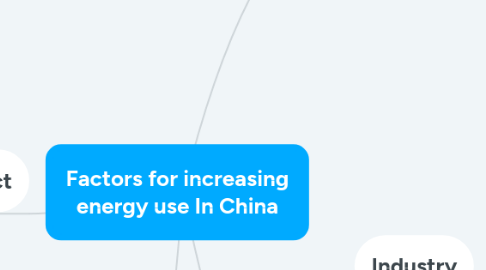
1. Energy-consuming and affluent lifestyle
1.1. Economic development + reform + opening-up
1.1.1. Increase living standards
1.1.1.1. In urban areas
1.1.2. Increase disposable income (可支配收入)
1.1.2.1. ∵ Creation of the middle class
1.1.3. Industrialization
1.1.4. Marketization
1.1.5. can afford more luxurious goods
1.1.5.1. private cars
1.1.5.2. garments
1.1.5.3. electronic devices
1.1.6. increase production to meet the demands
1.1.7. More production → more energy used to produce
1.1.7.1. E.g. coal in factories
1.1.8. Business expansion
1.1.9. More job opportunities
1.1.10. Residential consumption
1.1.10.1. Households
1.1.10.2. Transportation
1.1.10.3. Building materials
1.1.11. Production consumption
1.1.11.1. industrial
1.1.11.2. Construction
1.1.11.3. Service
2. Impact
2.1. Smog
2.2. Environmental disruption
3. Economic Growth and Industrialization
3.1. Industrialization
3.1.1. The result of economic reform and opening-up (Open Door Policy) by Deng
3.1.2. ∵ lack of raw materials and resources in the 1970s (low production rate)
3.1.2.1. ∴ need to attract foreign investors to bring $$$ (investments + resources)
3.1.2.1.1. ∴ lax environmental regulations (due to economic globalisation)
3.1.2.1.2. Investors set up industries
3.1.2.1.3. Advantages for investor: cheap land + labour in china + low production cost
3.1.2.2. ∴ set up and expand of 1️⃣ Labour intensive and 2️⃣ Low-end processing 3️⃣ Energy intensive heavy industry
3.1.2.2.1. Examples of heavy industry: iron industry, steel industry
3.1.2.2.2. Effects: increase energy use to support development
3.2. Economic reform
3.2.1. Special Economic Zones (SEZs)
3.2.1.1. Shantou
3.2.1.2. Zhuhai
3.2.1.3. Hainan
3.2.1.4. Shenzhen
3.2.1.5. Xiamen
3.2.2. Coastal Development Plan
3.2.2.1. Aim: A strong China
3.2.2.2. Processing industry
4. Urbanizaton
4.1. Economic reform and opening up
4.1.1. The set up of labour-intensive industries in the coal countries (1980)
4.1.1.1. Migrant workers (cheap labour)
4.1.1.2. Increase urban population
4.1.2. Peasants moving into cities to increase internal demand
4.1.3. Living
4.1.3.1. Households
4.1.3.2. Transportation
4.1.3.3. Buildings
4.1.4. Production
4.1.4.1. Industries
4.1.4.2. Constructions
4.1.4.3. Services
5. Industry
5.1. Northwest: Heavy industry
5.2. West: Energy supply
5.3. Central China: Industry, agriculture to support the East
5.4. East: Industry + commerce + overseas trade
6. Summary of factors
6.1. Rapid economic growth and industrialization
6.2. Energy-consuming and affluent lifestyle
6.3. Urbanization
6.4. Low environmental standards
6.4.1. Vested interest of companies → Low quality of coal and oil → more air pollutants released
6.5. Lack of legislation and enforcements
6.5.1. Unclear environmental law
6.5.2. Loose enforcement punishment of violators → they does not care about the environment → A continuous loop/ cycle
